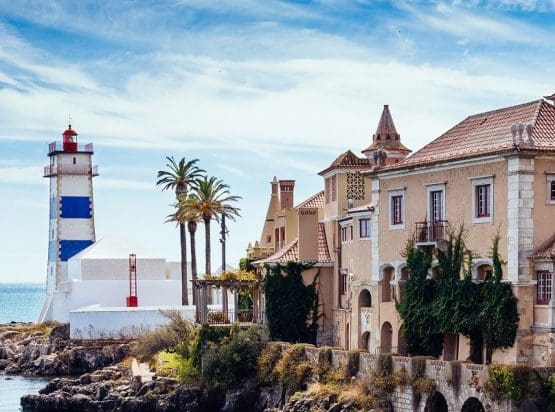Uncover Cascais's vibrant flavors and culinary gems with our expert guides. Plan an unforgettable trip now!
Read more
EXPLORE ALL OUR GUIDES TO PORTUGAL'S WINE REGIONS
Last updated: November 27, 2023
They say that size is no guarantee of quality. In which case, let us introduce you to Portugal’s Setúbal Peninsula. It is a small demarcated region south of the River Tagus – a place of endless fascination and timeless beauty. Historically, Setúbal was renowned for producing the iconic “Moscatel de Setúbal” (Muscat of Alexandria), an unbelievably delicious orange elixir of a wine. There is also a rarer, purple version: Moscatel Roxo. This lightly fortified, aromatic sweet tipple was the preferred drink of the aristocracy for many centuries. Aged versions have few rivals in the world of after-dinner drinks; young blends are sublime when paired with Portugal’s exquisite custard tarts.
Sadly, the demand for sweet – and fortified – beverages has plummeted over the past few decades. In an age of moderation and wellness, ‘sticky’ sweet Moscatel is not an easy sell. Indeed, you’d have more luck promoting a Bernard Matthews convention to a gang of turkeys. As a result, the emphasis has shifted to the exceptional dry styles made in the peninsula, not least the wines of Palmela. They are much more important today than sweet concoctions of Setúbal; this premier DOC (appellation) is increasingly being exploited by growers, used to make structured red and white wines of intoxicating perfume and finesse. They deserve a closer look.
The Setúbal Peninsula captivates oenophiles, gastronomes, and history buffs alike. Indeed, the region’s claim to fame is a major deal in the world of viticulture: this is believed to be the birthplace of the first grapevines in the Iberian Peninsula, planted around 4000 years ago. Their architects, it is thought, were an ancient civilization from modern-day Andalusia called the Tartessians. After that, the Phoenicians founded the town of Sétubal around 1000 BC and are credited with creating the local wine industry, trading wines for other goods on their seafaring expeditions. Custody then passed to the Celtiberians, a tribe that once dominated a province known as Lusitania (the modern geographical border runs from the Douro to Tagus rivers). However, the Romans eventually conquered this vast territory, controlling the Iberian Peninsula for centuries.
Yet their power severely weakened in the 5th century, culminating in the Western Empire’s implosion in 476 AD. This was a dangerous time for the citizens of Hispania; rival powers fought bloody battles to appropriate Rome’s lost possessions. During the Dark Ages, the Sarmatians, Alans, and Vandals tried their luck, but to no avail. However, a tribe known as the Suebi managed to maintain control until 585 – the Visigoths were no more successful at establishing a permanent base in the peninsula. Maintaining a precarious stamp of authority in their appointed capital Toledo (Castilla La Mancha), the Visigoths were quickly defeated by the Moorish armies of Tariq after he landed on Andalucian soil in 711. Over the next five centuries, the Moors transformed the cultural and social life of the Iberian Peninsula, establishing a Western caliphate that endured until 1492.
However, the reconquest of lands held by the Moors began in the 9th century. By 1147, Lisbon was back in Christian control; the newly created kingdom of Portucale soon expanded from Lisbon into Alentejo and the Algarve. This was the beginning of Portugal’s golden age, a period of rapid change that reached its zenith during the voyages of Vasco de Gama. At the same time, his contemporaries began to colonize Brazil. By the 14th century, the sweet nectar of Setúbal was being used to toast the health of several monarchs, not least in the court of Richard II of England. Historians believe Louis XIV of France was another acolyte of Sebútal – he imported a significant volume of Moscatel for his banquets and lavish palace events. So highly regarded were these wines that they were sent out with the ships in the Portuguese age of exploration; the barrels would usually be stored in the base of the ship, where they would be tossed and shaken by the waves, absorbing the saltiness from the sea and subjected to extensive temperature ranges. Astonishingly, this positively affected the aging and evolution of the wines.
They remained popular across Europe until the mid-20th century – the DOC Setúbal appellation was officially demarcated in 1907. Today, these relics of a bygone age command a small yet doggedly loyal following among aficionados of sweet wines. Nevertheless, their role in the overall wine economy of Lisbon is regrettably minute.

Visitors to Lisbon have no excuse: Setúbal is easily accessible from that great city just south of Portugal’s handsome capital. Home to several iconic wine estates – Bacalhôa and José Maria da Fonseca are legends abroad – the peninsula is a veritable tourist paradise. Indeed, less than 25 miles from Lisbon is a verdant landscape dominated by the lush Arrábida Natural Park, while pristine Atlantic beaches throng with holidaymakers in the summer.
Yet, in a sense, the above gives the wrong impression. Setúbal is a working vineyard rather than an ersatz tourist playground. Its terroir is exceptional: between the Tagus and Sado estuaries, southeast of Lisbon, with clay-limestone soils of unrivaled potential, cooled by Atlantic winds. The finest sites are planted on the lower slopes of the Serra Arrabida hills; sandy soils are more common around the town of Palmela. Without the influence of the Atlantic, maintaining acidity in this Mediterranean climate (there is scant rainfall in the summer) would be no easy task. But, the prevailing air currents straight off the ocean ensure vine canopies do not bake in the intense sunlight. For that reason, inland vineyards are far less suited to white wine production than the premier climats (vineyard sites) of Setúbal DOC.
The Setúbal peninsula is home to two key appellations: Setúbal and Palmela DOCs. The former needs no introduction to lovers of fortified wines. Based on the local strain of Muscat de Alexandria, the regulations permit the inclusion of a small percentage (maximum 30%) of additional varieties, including Arinto, Malvasia, and Roba de Ovelha. But in practice, Moscatel is usually over 85/90 percent of the final blend.
The winemaking culture in Setúbal is unique. The production of both Port and Sherry strongly emphasizes the role of grape spirit; this is added either during the primary fermentation (in the case of Port) or after all the sugar has been transformed into alcohol – standard practice in the cellars of Jerez de la Frontera. This strengthens the wine, increasing its alcohol and providing a powerful defense against oxidation and spoilage. However, they do things quite differently in this part of Portugal.
In Setúbal, the vinification process is haltered with the addition of Moscatel pomace (grape leftovers), most crucially, the skins. This explosive combination of pomace and partially fermented juice is left to macerate for as long as six months – occasionally longer. The result is a powerfully floral wine, always matured in wood for several years (normally at least four). However, the best cuvées are aged for decades before release: they compete with the finest Sauternes in the category of legendary sweet wines. Expect a glass of spicy hedonism with all the aromatic potency of Argentine Torrontes.
Winegrowers in Palmela, meanwhile, continue to make balanced, elegant dry wines of real interest. Red Palmela usually contains a good dollop (67 percent minimum by law) of Castelão, grown on sandy terroir to the east of the town. Yet it is not unknown for producers to add a dash of Cabernet Sauvignon, Tempranillo, and/or Syrah to the final blend. The best of this firmament is endowed with crunchy red fruit, ripe acidity, and firm tannins, a perfect wine, in other words, to enjoy with the hearty cuisine of Setúbal’s many atmospheric taverns. In addition, a small (but growing) volume of white wines is marketed under the Palmela DOC banner. You’ll be amazed at the finesse of these Fernão Pires/Moscatel blends: a hallmark of how many talented winemakers reside here.
Progress in the vineyards of Estremadura (an antiquated term for this part of central Portugal) continues apace, and oenophiles have to contend with new producers, ongoing innovation, grape experimentation, and ever-better wines. After decades of neglect, a resurgence in domestic demand – and growing tourism – has reinvigorated the appellations that once supplied northern Europe with vast quantities of wine. The roll call is impressive: Bucelas, Carcavelos, and Colares have all made great strides in attracting new investment and interest. Yet Setúbal DOC remains an outlier among the collection of zones that spread out from Portugal’s capital. There have been no dramatic shifts of fortune; the demand for sweet fortified wines is as paltry as it was 20 years ago. The flame is kept alive just by a few acolytes in restaurants and the specialist wine trade. Nevertheless, greatness (at least in terms of demand) is unlikely ever to return.
However, Palmela is on a roll. It seems hardly a month passes without the appearance of a new dry style made in these privileged vineyards, but that’s Portugal for you. A nation that still has plenty left to prove. Both the red and white wines impress; 20 years ago, visitors to a winery would view dilapidated equipment and rustic facilities. Today, they marvel at the state-of-the-art chais (barrel cellars) and modern paraphernalia. The two currently most impressive varieties are Castelão (naturally) and Arinto. The former grape, understandably seen as the appellation’s USP, is moving away from the astringent caricature of old into something more elegant and supple: a competitor to Pinot Noir. Smatterings of Chardonnay and Sauvignon Blanc show the potential for international white wine styles; however, Portuguese grapes remain the top dogs as they should.
Arinto is a versatile white wine grape variety known for its crisp acidity, citrus, green apple flavors, and a mineral finish
Find out moreAntão Vaz: Popular Portuguese white wine grape, grown in Alentejo. Known for its fresh acidity, ideal for casual and fine dining.
Find out moreChardonnay is a green-skinned grape varietal native to the Burgundy wine region in France and one of the most popular varieties worldwide.
Find out moreThis white grape variety produces aromatic wines with floral notes and a hint of sweetness, known for its versatility.
This variety is known for its floral and fruity aroma and delicate flavor profile. It produces crisp, refreshing wines with notes of citrus, peach, and pear and is often used in blends to add complexity and balance. Easy-drinking and food-friendly.
The sauvignon blanc grape varietal, originally from the Bordeaux region of France, is now one of the world's most loved white varieties.
Find out moreRabo de Ovelha produces full-bodied, aromatic wines with tropical fruit, apricot, and honey flavors. This rare grape is known for its high sugar content and is often used in sweet wine production. Despite its name, which translates to "sheep's tail," Rabo de Ovelha produces elegant and complex wines that pair well with desserts, cheeses, and spicy dishes.
Discover the versatile grape: Spain's Tempranillo, and in Portugal, Aragonês and Tinta Roriz (Douro Valley). Embrace the rich cultural tapestry of this beloved varietal.
Find out moreAlicant Bouschet is a red wine grape popular in the Alentejo located in Southern Portugal. It's a cross of Petite Bouschet and Grenache grapes.
Find out moreUnearth the bold allure of Bastardo wine grape. A unique gem with dark berry richness and a touch of spice. Elevate your wine experience today.
Find out moreUncover the allure of Periquita grape varietal, a hidden gem in Portugal's wine tradition. Experience new flavors and sensations with this authentic red wine.
Find out moreDiscover the irresistible allure of Cabernet Sauvignon—a worldwide favorite with robust, dark-bodied flavor. Unleash your wine journey today!
Find out moreMerlot is the most cultivated grape in Bordeaux and closely related to Cabernet Franc
Find out moreTinta Amarela, aka Trincadeira, is a red grape used in Port and red wine. Thrives in dry, hot climates, flaunting purple-skinned allure but susceptible to rot.
Find out moreBeautiful Setúbal is not simply a pretty face. It’s also a center of fine gastronomy – heaven for visiting gourmands. The area is renowned for its extraordinary seafood and fresh fish (oysters, red mullet, cuttlefish, and the ubiquitous sardines, adored by the Portuguese). The gastro jewel in the crown, though, is the Azeitão cheese. This handcrafted, artisan sheep’s milk cheese is cured and truly delicious. It deserves a memorable wine pairing.

Uncover Cascais's vibrant flavors and culinary gems with our expert guides. Plan an unforgettable trip now!
Read more
Uncover Lisbon's vibrant flavors and culinary gems with our expert guides. Plan an unforgettable trip now!
Read more
Uncover Sintra's vibrant flavors and culinary gems with our expert guides. Plan an unforgettable trip now!
Read moreIf you would like us to customize an exclusive luxury tour, contact us and let us know your travel plans. We offer luxury food and wine tours for private groups of a mininium two guests. In addition, all of our private, chauffeured tours are available year-round upon request.

